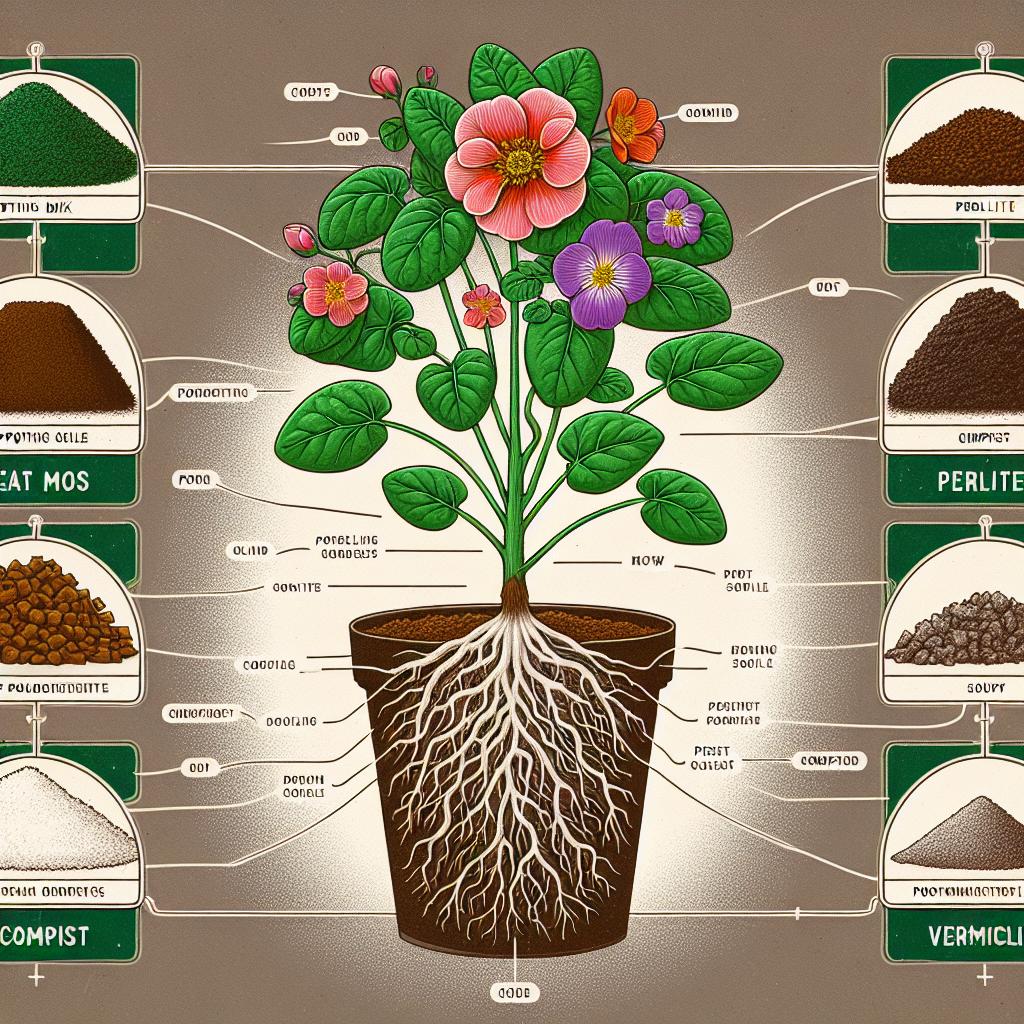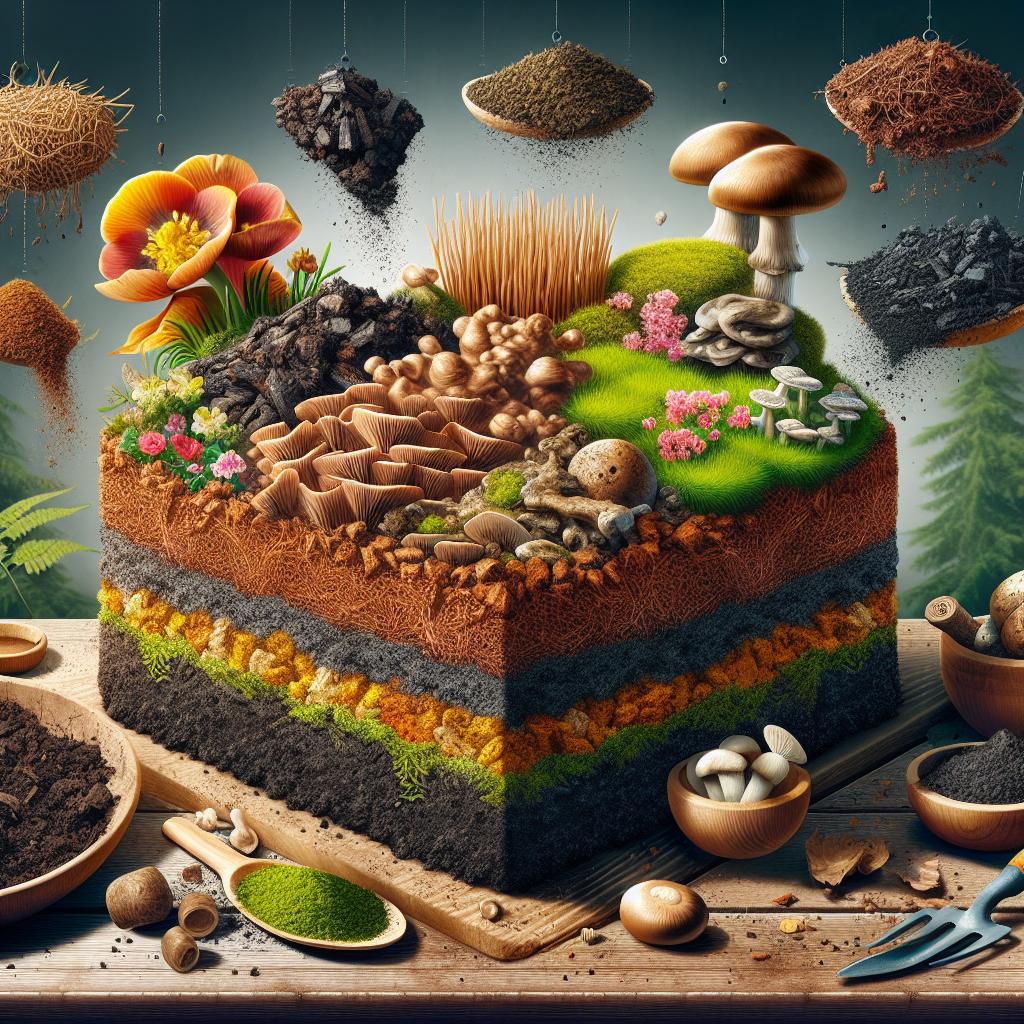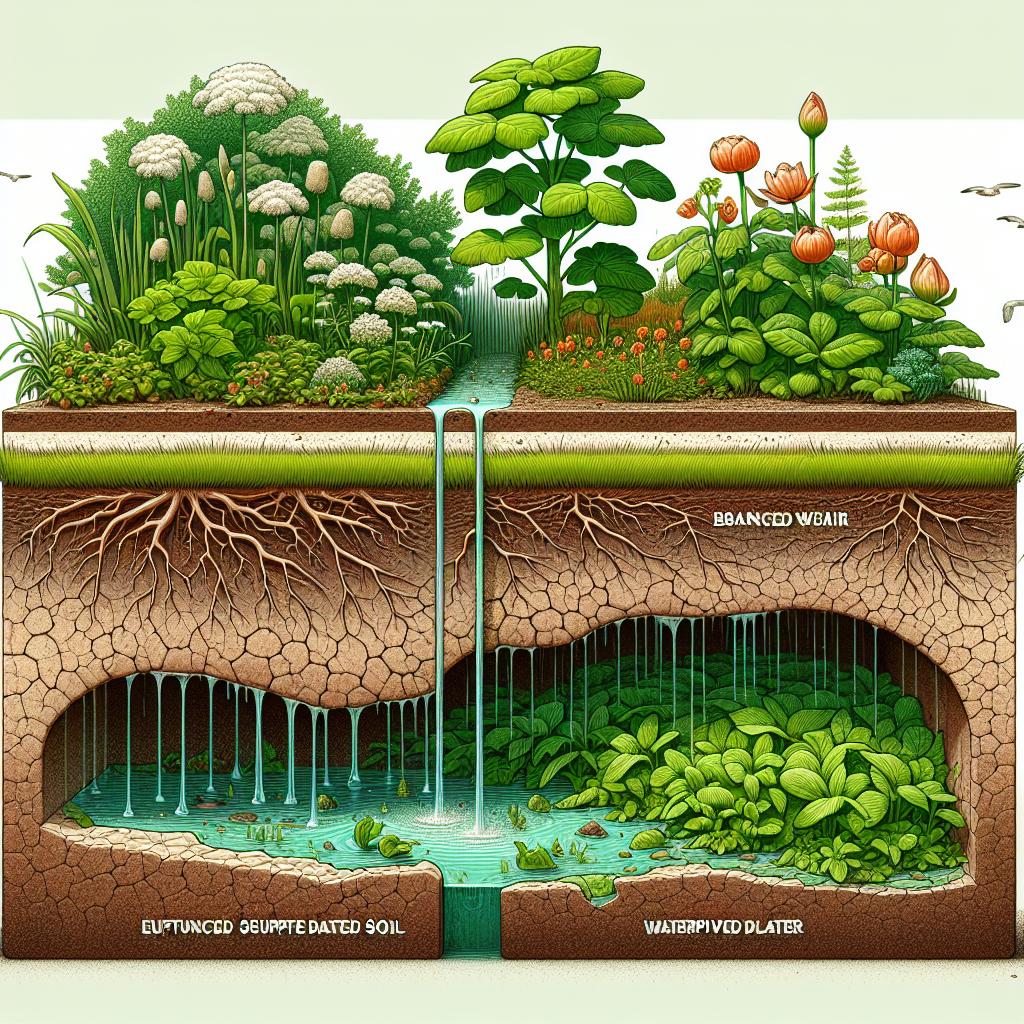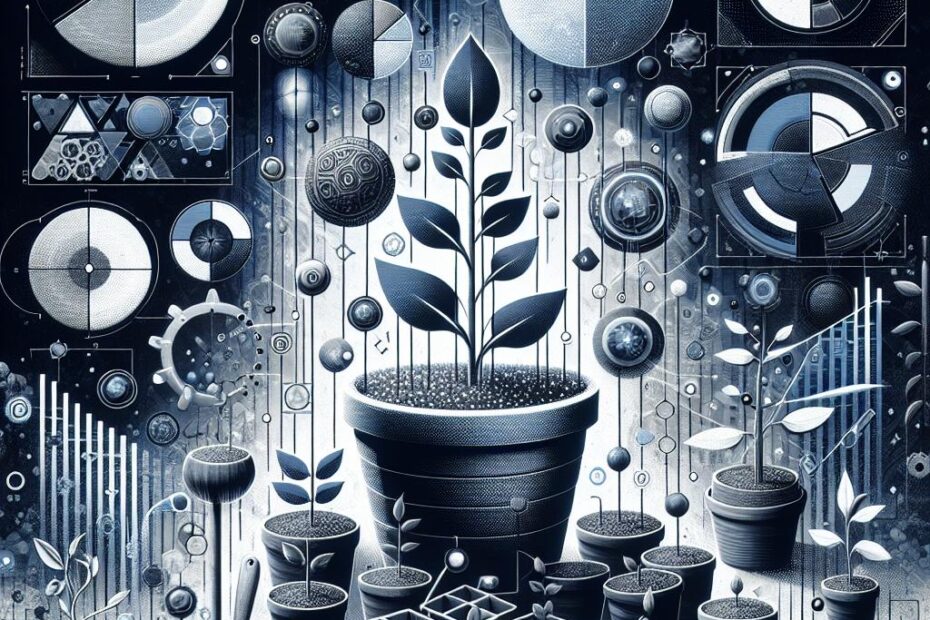The dance between green thumbs, soil enthusiasts, and potting soil mix ratios is a bewitching waltz, where every step could either elevate your plants to new heights or leave them stumbling in wilting despair. In this botanical journey, we find ourselves in search of the perfect concoction, a recipe for success that will nourish our beloved sprouts, shoots, and foliage. Join us as we venture into the realm of potting soil mix ratios, unraveling the mysteries that lie within, and unlocking the secrets to bountiful plant parenthood. Whether you’re a gardening guru or just dipping your toes into the fertile world of potting soils, it’s time to unearth the secrets of the perfect blend, for the flourishing oasis you’ve always dreamed of awaits.

Understanding the Potting Soil Mix Ratio
One of the most important aspects of successful gardening is . The ratio refers to the combination of different ingredients used in creating the ideal soil mix for your plants. By understanding and implementing the right mix ratio, you can provide your plants with the perfect balance of nutrients, moisture retention, and drainage to promote healthy growth and productivity.
When it comes to potting soil mix ratios, there is no one-size-fits-all solution. The ideal mix will vary depending on the specific needs of your plants, as well as the environmental conditions they are growing in. However, there are some general guidelines to consider. A common potting mix ratio consists of:
- Organic matter: Composed of decomposed plant material, it provides essential nutrients and improves soil structure.
- Coarse materials: Such as perlite or sand, aid in drainage and prevent soil compaction.
- Sphagnum peat moss: Known for its excellent water retention properties, it helps to keep the soil evenly moist.
- Fertilizer: A balanced blend of nutrients to support plant growth and development.
To give you a better understanding, here is an example of a potting soil mix ratio table:
| Ingredient | Ratio |
|---|---|
| Organic matter | 50% |
| Coarse materials | 25% |
| Sphagnum peat moss | 20% |
| Fertilizer | 5% |
Remember, these ratios can be adjusted based on your specific plants’ needs and growing conditions. It is essential to experiment and find the right balance that works best for your gardening goals. By understanding and mastering the potting soil mix ratio, you can give your plants a healthy foundation for growth, enabling them to thrive and flourish.

Key Components of a Successful Potting Soil Mix
Creating the right potting soil mix is an essential foundation for healthy and thriving plants. In order to achieve optimal results, it is crucial to understand the key components that make up a successful potting soil mix. By understanding the right ratios and combinations, you can create an environment that promotes root growth, nutrient absorption, and moisture retention.
Here are some key components to consider when creating your potting soil mix:
- Organic matter: Incorporating organic matter, such as compost or aged manure, adds valuable nutrients to the soil and improves its overall structure. It enhances water retention while still allowing for proper drainage.
- Perlite: Adding perlite to the mix helps increase aeration and drainage. It prevents the soil from becoming compacted and allows roots to breathe.
- Vermiculite: Vermiculite holds moisture and nutrients in the soil, preventing rapid drying and ensuring that plants have access to the necessary resources.
- Sand: Adding sand to the mix can improve drainage, especially for plants that prefer dry conditions or are prone to root rot. However, it should be used sparingly to avoid creating a mixture that becomes too dense.
| Component | Benefits |
|---|---|
| Organic Matter | Provides nutrients and improves soil structure |
| Perlite | Enhances aeration and drainage |
| Vermiculite | Retains moisture and nutrients |
| Sand | Improves drainage for plants preferring drier conditions |
Remember, the ratio of these components may vary depending on the specific plants you are growing. Some plants prefer a more moisture-retentive soil, while others thrive in well-draining mixtures. Consider the needs of your plants and experiment with different ratios until you find the perfect balance for their optimal growth. Your potting soil mix should be a tailored recipe that suits the unique requirements of your plants and helps them thrive.

Choosing the Right Proportions for Optimal Plant Growth
Potting Soil Mix Ratio
When it comes to , the potting soil mix ratio plays a crucial role. The composition of the soil determines the nutrients available to the plants, the water-holding capacity, and the overall health and vitality of your garden. Finding the perfect balance will not only provide a suitable environment for your plants to thrive but also help you achieve the desired results.
To create an ideal potting soil mix, consider the following tips:
- Organic Matter: Incorporate organic matter such as compost or aged manure into the soil mix. This will enhance the soil’s fertility and improve drainage.
- Coarse Materials: Adding coarse materials like perlite or vermiculite to the mixture can promote aeration and prevent compaction, allowing the roots to breathe and grow freely.
- Nutrient Balance: Ensure a good balance of nutrients in your mix by adding a slow-release fertilizer or using a pre-mixed potting soil that contains essential nutrients. This will provide a continuous and balanced supply of nutrients to your plants.
Keep in mind that different plants have varying requirements, so it’s essential to research the specific needs of your chosen plants and tailor the soil mixture accordingly. By experimenting with different ratios and observing the growth and health of your plants, you can fine-tune the potting soil mix to optimize their well-being and help them reach their full potential.
| Ingredient | Ratio |
|---|---|
| Organic Matter (Compost) | 1 part |
| Coarse Material (Perlite) | 1 part |
| Coarse Material (Vermiculite) | 1 part |
| Topsoil | 1 part |
| Slow-release Fertilizer | ¼ part |
| Sand | ½ part |
While the above ratio is a general guideline, remember that it can be adjusted based on the specific needs of your plants. Feel free to experiment with different proportions and observe the impact on growth and health. Keep in mind that regular monitoring and adjustments to the potting soil mix can help ensure optimal plant growth and development.

Examining the Role of Organic Matter in Potting Soil
When it comes to creating the perfect potting soil mix, one of the key ingredients that cannot be overlooked is organic matter. This natural material plays a crucial role in providing the necessary nutrients, retaining moisture, and improving the overall structure of the soil. To achieve the ideal potting soil mix ratio, it is important to understand the benefits of incorporating organic matter into your blend.
Benefits of Organic Matter in Potting Soil:
- Enhanced Nutrient Availability: Organic matter acts as a reservoir for essential nutrients, releasing them gradually over time. This helps to sustain plant growth and development, ensuring a healthy supply of vital nutrients.
- Improved Water Retention: The presence of organic matter in potting soil enhances its water-holding capacity. This allows the soil to retain moisture for longer periods, reducing the frequency of watering and preventing the excessive drying of the plant’s root system.
- Promotion of Beneficial Microorganisms: Organic matter serves as a food source and habitat for beneficial microorganisms in the soil. These microorganisms break down organic matter, releasing additional nutrients, improving soil structure, and suppressing harmful pathogens.
Optimal Ratios of Organic Matter:
While the exact ratio of organic matter in potting soil can vary depending on specific plant requirements, a general guideline is to aim for a mix of 25-50% organic matter. This ensures a healthy balance between nutrition, moisture retention, and soil structure. Exceeding this ratio may result in excessive water retention and poor aeration, which can lead to root rot and other plant health issues.
| Organic Matter | Benefits |
|---|---|
| Compost | Rich in essential nutrients and microorganisms |
| Leaf Mold | Excellent water retention and aeration properties |
| Peat Moss | Highly absorbent and helps with moisture regulation |
By incorporating the appropriate amount of organic matter into your potting soil mix, you can create an environment that fosters healthy plant growth and thriving root systems. Experiment with different organic materials to find the perfect balance for your specific plant needs.

The Importance of Drainage: Balancing Moisture Levels in the Mix
When it comes to potting soil mix ratios, finding the perfect balance of moisture is key to the success of your plants. Proper drainage is crucial as it helps to prevent waterlogged roots, which can lead to root rot and ultimately the death of your beloved plants. By maintaining an ideal moisture level, you are creating an environment that allows roots to breathe and absorb nutrients efficiently, promoting healthy growth.
One way to achieve the right moisture balance is by including organic matter such as peat moss or coconut coir in your potting soil mix. These organic materials help to improve drainage by enhancing the soil’s ability to retain some moisture while allowing excess water to flow through. Mixing them in with your soil creates a light and airy texture that aids in water movement, ensuring that your plant roots are adequately hydrated without drowning.
- Consider adding perlite or vermiculite: These additives can further improve drainage by increasing the air space within the soil mix. Their lightweight nature helps to prevent compaction, allowing water to flow freely.
- Use a smart watering schedule: While a well-draining soil mix is crucial, it’s equally important to water your plants properly. Avoid overwatering by letting the top inch of soil dry out between waterings. This will prevent moisture build-up and encourage root growth towards the bottom of the pot.
By understanding the importance of maintaining a well-balanced moisture level through proper drainage, you can ensure the long-term health and vibrancy of your potted plants. Remember, every plant has unique watering requirements, so it’s essential to find the right potting soil mix ratio that suits the specific needs of your green companions.

Enhancing Nutrient Retention: Finding the Right Balance for Fertilizers
Finding the right balance for fertilizers is essential in enhancing nutrient retention in your potting soil mix. By carefully considering the nutrient needs of your plants and adjusting the ratios of fertilizers accordingly, you can create an optimal growing environment that promotes healthy growth and maximizes nutrient uptake.
When it comes to potting soil mix ratios, it’s important to understand that different plants have different nutrient requirements. Some plants thrive in nutrient-rich soil, while others prefer a more balanced blend. To achieve the perfect balance, you can follow these tips:
- Research your plant’s nutrient needs: Each plant has specific requirements for essential nutrients such as nitrogen, phosphorus, and potassium. Knowing these requirements will help you determine the appropriate ratio for your potting soil mix.
- Consider the growth stage: Different plants have varying nutrient requirements at different stages of growth. For example, during the vegetative stage, plants may require higher nitrogen levels, while during flowering, phosphorus becomes more important. Adjust the fertilizer ratios accordingly to support the plant’s growth stage.
- Experiment with different ratios: Start with a balanced potting soil mix and gradually adjust the ratios based on the plant’s response. Keep track of any changes you make and monitor the plant’s health and growth to find the optimal fertilizer balance.
In addition to adjusting the nutrient ratios, it’s also crucial to ensure proper nutrient retention in your potting soil mix. Here are some strategies you can employ:
- Organic matter: Incorporate compost or decomposed organic matter into your potting soil mix. These materials improve nutrient retention by enhancing the soil’s ability to hold onto essential nutrients.
- Water management: Proper watering practices can prevent nutrient leaching. Avoid overwatering, as excessive water can wash away nutrients. Use a well-draining soil mix that allows for adequate moisture retention without becoming waterlogged.
- Slow-release fertilizers: Consider using slow-release fertilizers that gradually release nutrients over time. This ensures a steady supply of nutrients for your plants and minimizes nutrient loss through leaching.
By finding the right balance for your fertilizers and implementing strategies to enhance nutrient retention, you can create an ideal potting soil mix that promotes healthy plant growth and reduces the risk of nutrient deficiencies.

Exploring Different Soil Mix Ratios for Specific Plant Types
When it comes to potting plants, choosing the right soil mix ratio can make a world of difference in their overall health and growth. Different plant types have unique requirements, which is why it’s important to understand how different soil mix ratios can affect them. By experimenting with various ratios, you can create the ideal growing conditions for your plants.
Here are some soil mix ratios that you can try for specific plant types:
- Cacti and Succulents: These desert-loving plants thrive in well-draining soil. A mix of 50% coarse sand, 25% potting soil, and 25% perlite or pumice can provide the perfect balance for their root systems.
- Leafy Greens: Plants like lettuce and spinach prefer nutrient-rich soil that retains moisture. Try blending 60% potting soil with 30% compost and 10% vermiculite to create a fertile mix.
- Orchids: Orchids are epiphytic plants that require good air circulation around their roots. Mix 60% bark chips or coconut coir, 20% sphagnum moss, and 20% perlite for an orchid-friendly potting medium.
Remember, these ratios serve as a starting point, and you can adjust them based on your specific plant’s needs. Some plants may require more sand for better drainage, while others might benefit from increased nutrient content. It’s always a good idea to research the specific requirements of your plant species before experimenting with different soil mix ratios.

Fine-Tuning Your Potting Soil Mix Ratio for Improved Plant Health
Fine-tuning your potting soil mix ratio can make a world of difference when it comes to the health and vitality of your plants. An optimal mix will not only provide the necessary nutrients, but also ensure proper drainage and aeration. Finding the right balance may take some experimentation, but the effort is well worth it.
Here are a few tips to help you achieve an improved plant health by adjusting the potting soil mix ratio:
- Proportion of Organic Matter: A good potting mix typically contains a blend of organic materials such as compost, peat moss, and coconut coir. Achieving the right ratio of these elements helps retain moisture while allowing ample drainage.
- Sand and Perlite: Adding sand or perlite to the mix can greatly enhance the drainage and prevent waterlogged roots. Finding the ideal ratio of sand or perlite to other ingredients will largely depend on the type of plants you are growing.
- Mineral Additives: Consider incorporating mineral additives like vermiculite or pumice into your potting soil mix. These materials improve aeration and provide crucial trace elements that promote plant growth and overall health.
- pH Balance: pH plays a crucial role in nutrient availability. Testing and adjusting the pH of your potting mix can make a significant difference in how well your plants absorb nutrients. For certain plants, adding amendments like lime or sulfur may be necessary to achieve the optimal pH range.
Remember, each plant has unique needs, and finding the perfect potting soil mix ratio may require some trial and error. Keep an eye on your plants’ growth and adjust the ratio accordingly, ensuring you provide them with the best possible environment for flourishing. With a little bit of experimentation and a touch of green thumb, you’ll be well on your way to fostering healthier and happier plants!

A Step-by-Step Guide to Creating the Perfect Potting Soil Mixture
When it comes to gardening, having the right potting soil mixture is essential for the health and growth of your plants. By understanding the perfect potting soil mix ratio, you’ll be able to provide your plants with the necessary nutrients, drainage, and aeration they need to flourish. Follow these step-by-step instructions to create the ideal potting soil mixture for your gardening needs:
Step 1: Gather the Ingredients
The first step in creating the perfect potting soil mixture is to gather all the necessary ingredients. You will need:
- High-quality garden soil
- Compost or organic matter
- Perlite or vermiculite for improved drainage
- Sand or grit for added aeration
- Fertilizer
Step 2: Mix the Ingredients
Once you have gathered all the ingredients, it’s time to mix them together. Follow this potting soil mix ratio:
| Ingredient | Ratio |
|---|---|
| Garden soil | 2 parts |
| Compost | 1 part |
| Perlite or vermiculite | 1 part |
| Sand or grit | ½ part |
| Fertilizer | A sprinkle |
Combine the ingredients in a large container or wheelbarrow and mix thoroughly. Ensure that the mixture is well-blended, and there are no clumps or lumps. The result should be a light, well-draining potting soil mix that provides adequate moisture and nutrients for your plants.
Q&A
Q: Are you tired of struggling with your potted plants? Wondering if there’s a secret recipe for the perfect potting soil mix ratio? Look no further! We’ve got all the answers you need to help your green buddies thrive.
Q: What is the ideal potting soil mix ratio?
A: The ideal potting soil mix ratio can vary depending on the type of plants you have. However, a good general guideline is a mix of approximately 1 part organic matter, 1 part inorganic matter, and 1 part moisture retention components.
Q: What falls under organic matter?
A: Organic matter includes substances such as compost, mulch, or decomposed leaves. These materials provide essential nutrients and improve soil structure, allowing your plants to absorb water and nutrients more efficiently.
Q: What is considered inorganic matter?
A: Inorganic matter refers to materials like perlite, vermiculite, or sand. These components ensure proper drainage, which prevents water from stagnating in the soil and harming your plants’ roots.
Q: Why is moisture retention important?
A: Moisture retention components, such as sphagnum moss or peat moss, help to retain water in the soil, ensuring your plants have a consistent supply of moisture. They prevent the soil from drying out too quickly, particularly in warm or arid climates.
Q: Can I customize the potting soil mix ratio?
A: Absolutely! Depending on the requirements of your plants, you may need to tweak the ratio slightly. Some plants, like succulents, prefer a drier mix, while others gravitate towards moisture-rich environments. Experiment to find the perfect blend that suits your specific plant’s needs.
Q: Can potting soil be reused?
A: While potting soil can be reused, it’s important to refresh it periodically. After a growing season, remove any dead plant material and loosen the soil. You can then add fresh organic matter and inorganic matter to replenish the nutrients and ensure proper drainage.
Q: Is potting soil mix ratio the only factor in plant health?
A: No, the mix ratio is just one aspect. Other important factors include lighting, temperature, watering schedule, and the choice of fertilizer. Understanding and adjusting these variables in combination with the right soil mixture will help your plants flourish.
Q: Any tips for beginners looking to improve plant health?
A: Certainly! Start by selecting plants that thrive in your climate and are suitable for indoor or outdoor gardening. Study their specific needs and adjust accordingly. Remember to perform regular soil checks, monitor moisture levels, and maintain a proper fertilizing routine. Lastly, don’t hesitate to seek advice from experienced gardeners or local plant nurseries – they are treasure troves of knowledge!
By following these guidelines, finding the perfect potting soil mix ratio will become second nature to you, and you’ll witness your plants transform into magnificent, thriving beauties.
In Retrospect
As we bid farewell to this exploration of the perfect potting soil mix ratio, we hope you feel inspired to embark on your own botanical adventure. Remember, the secret to a thriving garden lies within the mix of ingredients you choose. Whether you opt for the gentle touch of peat moss or the nourishing embrace of compost, the possibilities for customizing your ideal soil blend are endless. So, dear green-thumbed reader, step into the world of horticulture armed with knowledge and creativity, and let your imagination blossom alongside your plants. May your pots overflow with vibrant life and your garden become a sanctuary of botanical wonder. Go forth and conquer the realm of potting soil mix ratios, and may your greenery flourish like never before!
